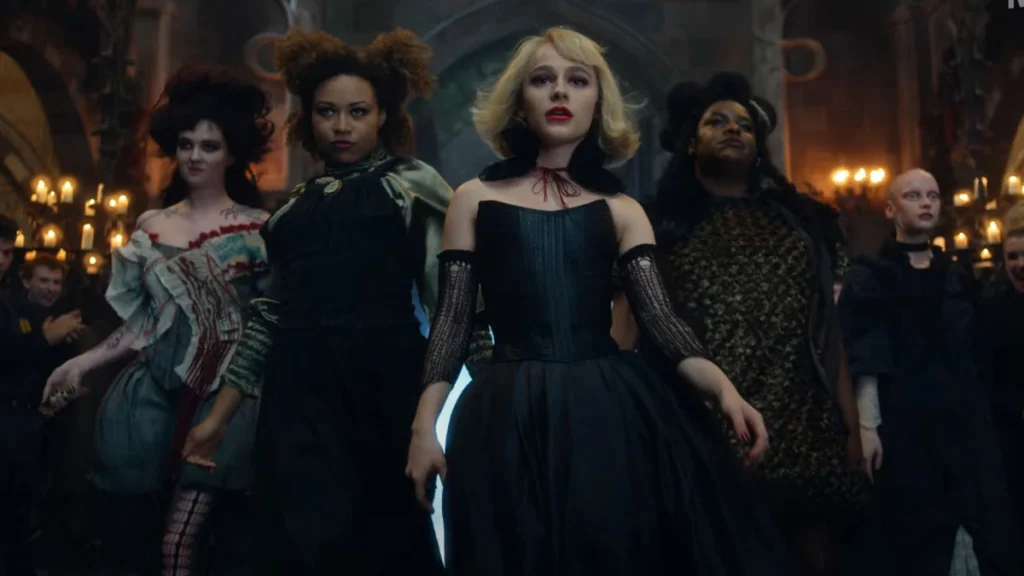The third act of The School for Good & Evil on Netflix has a significant revelation involving the villain, but the fairy tales in the movie lead up to this change. As it sets up two houses of an opposing school and positions the movie’s two heroines, Sophie (Sophia Anne Caruso) and Agatha (Sofia Wylie), on opposing sides, the plot of the movie is ripe for subversion and reversals. In addition to rejecting concepts like “good” and “evil,” the two main characters also learn that a far darker scheme is afoot at the school that serves as the basis for many of the fairy tales that exist in the human realm.
The key surprise in The Institution for Good & Evil is that the Headmaster (Laurence Fishburne), who has been posing as Rhian but is his identical twin Rafal (Kit Young), the origin of all evil in fairy tales, is the film’s villain responsible for the darkness at the core of the school. The movie deftly establishes this twist right away by demonstrating the corruptive power of the tales Rafal crafts from the school for heroes and villains, and this influence is on display through its effects on Sophie. It seems to reason that individuals who read them will unconsciously take on and mimic Rafal’s wickedness as he shapes the human world through his writings.
Even though Sophie is defined by fairy tales, she is evil.
According to The School for Good & Evil, evil hasn’t triumphed in 200 years. As a result, the tales that emerge from the school appear to be written with readers like Sophie’s best interests in mind. Even though Sophie is at the school for evil, she thinks that the stories she read should have changed her for the better since she retains and internalizes them, which helps them shape her worldview. With her description of her stepmother as a “wicked stepmother,” her attempts to befriend animals like the princesses in her novels, and the way she wields a saucepan as a weapon like the protagonist of Tangled, Sophie repeatedly proves this fundamental presumption throughout the movie. Sophie heads straight to the school for evil despite her desire to mimic the “good” heroines of her novels. This demonstrates how even individuals who are supposed to be “good” may engage in an evil activity because of the Headmaster’s stories and their nefarious impact. This hints from the start of the movie that something is up with the Headmaster’s management, which explains how one of his followers wound up in the school for bad reasons.
The Headmaster’s Plans Led To Sophie’s “Evil”
Finally, The School for Good & Evil shows how the Headmaster actively cultivated Sophie’s fall by instilling her with a sense of entitlement in addition to showing the subtle influence of the Headmaster’s stories encouraging villainous behavior in both past and present readers through the use of Sophie. Since Sophie aspires to be like the heroes in these tales, Sophie gains the conviction that she is good at The School for Good and Evil. However, this entitlement has a serious drawback since it makes her easier to target and influence whenever she enters the school, especially now that Agatha is permanently a student there.
She is simple to influence because she feels mistreated by being sent to the school for evil, and she is also immensely nasty because of her dogmatic belief that she understands where she lies on the spectrum between “good” and “evil.” The capacity to change and grow, especially the capacity to own their errors, is one of the real traits of heroes. But when faced with the underlying evil of a school that excommunicates students by transforming them into animals like the wish fish, Sophie and many other faculty members are unable to do so. After Sophie’s hopes—which had been raised throughout her childhood by the Headmaster’s stories—had been destroyed by her placement in evil, Rafal was able to directly control her by directing her studies and giving her darker talents. Because of this, the Headmaster’s intentions for her metamorphosis into an “evil” witch in The School for Good and Evil had both a direct and an indirect impact.
